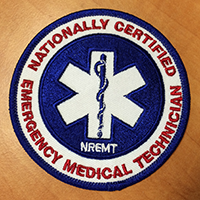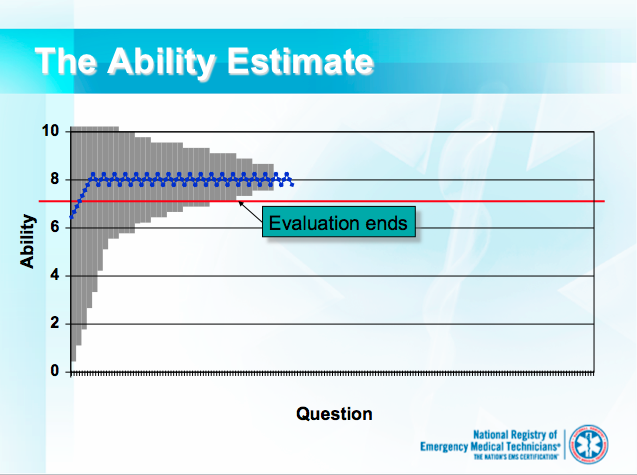Studying for Your EMT or Paramedic NREMT Exam? 3 Tips for Mastering Computer Adaptive Testing

In case you didn’t already know, the NREMT is a computer adaptive test. Computer adaptive testing (CAT) is becoming an increasingly common practice in the world of exams. For instance, the NCLEX (the exam nurses take for their national licensure) also uses CAT1.
But let’s back up and start with what does computer adaptive testing mean? How is it different from a regular computer-based test?
First, let’s define computer-based test. Essentially, this is any test that’s administered electronically through a computer--an alternative to what was historically more common, the paper and pencil test. For instance, Fisdap exams are computer-based tests. There’s a set list of questions (in our case, multiple choice) and the testing software allows the test administrator to randomize questions and instantly grade the test.
As for computer adaptive testing...well, this concept can get a bit complex. So, don’t just take it from me. Let’s ask Wikipedia2.
CAT successively selects questions for the purpose of maximizing the precision of the exam based on what is known about the examinee from previous questions. From the examinee's perspective, the difficulty of the exam seems to tailor itself to their level of ability. For example, if an examinee performs well on an item of intermediate difficulty, they will then be presented with a more difficult question. Or, if they performed poorly, they would be presented with a simpler question. Compared to static multiple choice tests that nearly everyone has experienced, with a fixed set of items administered to all examinees, computer-adaptive tests require fewer test items to arrive at equally accurate scores. (Of course, there is nothing about the CAT methodology that requires the items to be multiple-choice; but just as most exams are multiple-choice, most CAT exams also use this format.)
The basic computer-adaptive testing method is an iterative algorithm with the following steps:
- The pool of available items is searched for the optimal item, based on the current estimate of the examinee's ability
- The chosen item is presented to the examinee, who then answers it correctly or incorrectly
- The ability estimate is updated, based upon all prior answers
- Steps 1–3 are repeated until a termination criterion is met
So now that we’ve established what computer adaptive testing is and how it works, here are 3 tips for taking the NREMT.
1. Don’t be surprised if you see the “same” question.
The NREMT doesn’t repeat questions on a single user’s examination. Based on the CAT algorithm, however, you may see similar questions as the test aims to determine whether you meet the termination criterion (whether you should pass or fail).
If you get a question similar to one that you think you have already seen, don’t panic that you got the earlier question wrong. Don’t assume that you should change your response to be different--still answer the question to the best of your ability.
Also, keep in mind that the NREMT is pilot testing new items (test questions) all the time. In fact, each student will see a minimum of 10 pilot items at the EMT level and 20 at the paramedic level.
2. Don’t be alarmed if you get a difficult question right out of the gate.
Many teachers are conditioned to frontload easier questions on an exam with more challenging questions towards the end. Students learn this pattern of test-taking and get anxious if they start a test and it’s immediately “too hard.”
Again, because of the algorithm of CAT, the questions are randomized so it’s possible that you may get question that seems really hard to you right out of the gate.
For CAT to work, the computer is assessing whether you are above the passing bar. So if you get a question above the passing bar and you answer it correctly, you’ll get another difficult question. If you answer it incorrectly, the test will adjust to give you an easier question.
 3
3
This is a great illustration from the NREMT of how this works. Imagine that the red line, 7 on the ability axis, is the passing bar. Your goal is to answer enough questions with a difficulty level at or greater than 7 to stay above the passing bar. In the diagram, each blue dot represents a question. The candidate answered 6 and 7 ability level questions correctly and then answered questions (correctly and incorrectly, but enough correctly) to hover around the 8 difficulty level. That’s why the test eventually shuts off--a statistically valid number of questions were answered to determine the candidate would stay above the passing bar.
3. Don’t just study the “easy” stuff. Study with application or scenario-based practice questions.
Each item has an assigned difficulty rating, which allows the computer to give you an easier or harder question depending on how you answered the previous one. Terminal competence is determined when the candidate stays above the passing bar long enough for the test to be statistically confident that the candidate should pass. Then the test shuts off.
If the test only gives candidates questions with difficulty ratings beneath the passing bar, it is not a valid measurement of whether they can answer questions above the passing bar.
Hopefully all the questions seem easy to you because you are well prepared, however, don’t expect to get a lot of knowledge recall questions that ask you to name different bones in the body. You are more likely to see questions that ask you to make a decision about patient care and how you should treat medical and trauma patients.
One way you can study for scenario-based questions that ask you to apply your knowledge is to actually practice a scenario. Create a study group with your classmates. Each of you should prepare a scenario for the others to work through and then you can take turns directing, being the patient, and most importantly, practicing responding to a call.
Studying for the NREMT?
Download our essential test-taking tips!
References
1. https://www.ncsbn.org/1216.htm
2. http://en.wikipedia.org/wiki/Computerized_adaptive_testing
3. https://www.nremt.org/nremt/downloads/About%20CAT-Detailed.ppt
